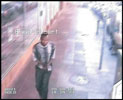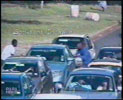

One of the most worrying 'unintended consequences' of the advent of democracy in South Africa in 1994, was the apparent upsurge in an attitude of contempt for the rule of law especially in urban and commercial areas.
Local and overseas media capitalised on this misfortune with harrowing reports detailing the wave of criminal activity that seemed to be sweeping the country.
In Cape Town, the explosion in street robbery and muggings was particularly unwelcome and unfortunate. The many foreign and local tourists to the city provided not only a constant source of revenue for the hospitality industry, but also for criminal elements who regarded the throngs of visitors as easy pickings.
A critical factor was the real decline in law enforcement manpower. Many members of the previous police force were ideologically and politically disconnected from the new democratic government, and either opted or were forced to resign. The outcome was a rapid drop of more than one third in law enforcement manpower - many with years of service and experience.
By 1998 the street-crime situation in the Mother City had become very serious indeed. Simultaneously, perhaps as a result of perceptions of ineffectual policing, Cape Town was hit by a series of bomb attacks on crowded public areas. There are few actions that destroy the public's confidence as rapidly as perceptions of personal danger to life and limb - and Cape Town's lucrative tourism industry found itself under very serious - and escalating - threat.

Inner-city surveillance begins
Urgent remedies were demanded, and in 1998 a public area surveillance system was implemented by John Penberthy, then an executive with Business Against Crime in the Western Cape. Penberthy had refined his concept of CCTV while spending time in Atlanta during the 1996 Olympic Games, where he prepared the security theme for Cape Town's bid for the 2000 Games.
So rapid - and so effective - were the results achieved by the SA Police in Cape Town using Penberthy's system (then operated as an independent offshoot from the Business Against Crime initiative) that street-crime diminished practically overnight! Tracking, tracing and bringing about the jailing of the urban terrorists who were planting bombs in the city, ranks high indeed among the system's most notable achievements!
Meanwhile, in Johannesburg at about this same time, street-crime had reached a point where it too seemed out of control.
However, having seen the remedy applied in Cape Town, Johannesburg's city authorities approached Penberthy, and during 1999 a pilot project was launched in the downtown's main 'hot-spot' areas.
During the installation phase while laying cables and installing cameras, the engineers were mugged four times, and on two occasions their jack-hammers were stolen! The same area today is a thriving hub of business activity.
The following year - in March 2000 - the new executive mayor Amos Masondo formally opened Cueincident's (formerly BAC) Operation Centre - located in the Carlton complex. Within months, the level of street-crime was showing dramatic reduction: by the end of the first year it had dropped to 60%, and was down an astounding 80% within a further 6 months! Today, Johannesburg is on a roll of regeneration - with new investment and signs of re-development everywhere.
The once-abandoned Carlton complex is again a hive of bustling activity: all 50 floors of the bellwether Business Tower are fully let, the shopping area is again operating at capacity and there is even talk of re-opening the famous Carlton Hotel - previously one of Africa's most prestigious hotels.

The players
Instrumental in this dramatic turn-around is the joint outcome of major co-operation between SAPS, Johannesburg Metro Police, the Central Johannesburg Partnership, Johannesburg Development Agency and Cueincident's Incident and Facilities Management technology.
"I realised in Atlanta that we needed to close the gap in our country's demand for skilled and trained manpower. Training takes time, and I recognised that by harnessing and adapting existing technology - in this case CCTV monitoring - we could achieve our objectives," John Penberthy says.
"We adapted the technology by approaching the issues intellectually, rather than merely seeking an engineering solution to a socio-economic problem. And we developed a system that enables our operators to 'patrol' areas by camera, identify and anticipate incidents, and 'track-and-trace' individuals even as they try to escape by running through the city. We work very closely with the SAPS and Metro Police, and our arrest rates have been very high, with convictions always following because the recorded material we produce is better than broadcast quality - and leaves no room for doubt."
The Cueincident system is also being implemented in Tshwane's downtown Pretoria CBD, and at Nissan's plant in the Rosslyn Automotive hub. Talks are underway with other domestic municipalities and some foreign countries.
"There is a serious misunderstanding about the use of this technology, however, and many people think that the CCTV cameras alone provide the solution. The cameras are only a means used by law enforcement agencies to access the system we have developed, and without our technology and the specialised training that our operators receive, it is impossible to achieve the sustainable outcome that we are able to guarantee.
"I can think of several CCTV camera systems that were implemented by municipalities and state-owned enterprises at considerable expense - using only the installed camera system - that today are functionally useless and represent a huge waste of public money," says Penberthy, who relinquished the position as CEO to Vusi Twala at the end of 2006.
More than just the technology
"Installing cameras and offering a CCTV system is simple. But to operate efficiently and consistently, and to provide proactive surveillance that predicts and prevents criminal activities requires the highest level of design including intellectual input and commitment.
"Merely installing cameras does not get the job done. Implementing a badly designed system simply means that innocent people are placed at greater risk because they are under the impression that they are being protected - when in fact they are even more vulnerable!
"The video material we produce is intended for use as evidence in court cases, and necessarily must be of the highest quality. In fact, the original design was researched and developed in collaboration with the SAPS and Department of Public Prosecution.
"We know, from our own experience across the country in operating our Incident Management system, that this achieves the most efficient use of manpower and resources on the ground, and provides a level of public and investor confidence that will ensure South Africa's long-term stability.
"Our contribution to the success story of down-town Johannesburg's revival from near-collapse is ample testimony to Cueincident's record of innovative and sustainable application. We are especially proud that the solution was developed and designed by South Africans, for South Africa," Twala concludes.
For more information contact Cueincident, +27(0)11 331 2100, [email protected], www.cueincident.com
© Technews Publishing (Pty) Ltd. | All Rights Reserved.